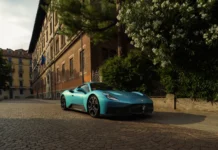WIn the world of JDM sports cars, the Toyota Supra has sat proud as one of one of its greatest offerings. A particular mid-1990s racing game cemented the A80 Supra in my mind, not to mention the late Paul Walker’s 1993 MkIV Supra from The Fast and The Furious that fetched a whopping $185,000 at auction in 2015. The car has built up one hell of a reputation, and now the legend has returned. The latest model has some big shoes to fill, rebooting a sports car name that was in production for nearly 30 years.

The new kid: MkV (A90/J29/DB)
2019 – present
Arguably, the 2020 Toyota Supra, now in its fifth generation, is the most controversial of the bunch. Why? Because a lot of you argue this isn’t a real Supra. To create the latest model, Toyota partnered up with BMW, rather than sourcing the entire car on their own.
To that end, Toyota is not building the latest model in Aichi Prefecture, Japan, as they had with the last four generations. Instead, Magna Steyr produces the Toyota Supra alongside its newly co-developed counterpart, the BMW Z4. While Toyota did use the code “A90” to show the Supra’s lineage, this one uses BMW’s naming conventions and model codes. Still, for history’s sake, we’re referring to the new Supra as the A90. There are distinct differences between the two. From the body to the engine tuning, suspension and overall aims of the car, the Supra’s engineers worked to interpret its legendary reputation in a new generation.
The 2020 Toyota Supra only has one engine choice: A 3.0-liter turbocharged straight-six engine with 335 horsepower and 369 lb-ft of torque. A 2.0-liter four-cylinder engine is available in Japan, with up to 255 horsepower and 295 lb-ft of torque. An eight-speed ZF automatic transmission is also your only option.

The legend: MkIV (A80)
1993 – 2002
This is the daddy, and mostly because of one thing: 2JZ. The all-new inline-six engine was beefier than the previous model thanks to a heavy-duty cast iron block. Yes, it is heavier than the aluminum block, but it’s also more durable. What made this version the darling of the JDM sports car scene in the 1990s was not just its looks or its platform — it was the huge horsepower you could squeeze out of that engine.

Out of the box, the A80 Supra Turbo made 320 horsepower and 315 lb-ft of torque. That’s a significant amount of shove, even by today’s standards. The naturally-aspirated version also wasn’t bad, making 220 horsepower. In 1994, you could actually get the Turbo with a six-speed Getrag manual transmission rather than the five-speeds of yesteryear. Toyota electronically limited the top speed to 155 mph, but it could achieve about 180 if you managed to take the limiter off.
The way this car looked, handled, went and stopped cemented the name throughout the car world. It was arguably the most driver-focused model yet, which undoubtedly endeared it to enthusiasts the world over. The big down side, however, was its price. It cost substantially more than the A70, and was a low-volume model.
Before Toyota withdrew it from the U.S. in 1998, they sold just over 11,000 units. That makes it the rarest of all Supras, which explains why well-kept examples are changing hands at six-figure prices.

Cutting Ties: MkIII (A70)
1986-1993
Toyota continued to evolve the Supra over time, separating the car from its Celica roots in the process. In 1986, Toyota decided to cut the ties entirely, dropping the Celica name from the lineup. From this point forward, the car would just be known as the Supra. The Celica, in turn, moved to a front-wheel drive platform offering four-cylinder engines. Here, the A70 Supra stuck to rear-wheel drive and inline-six engines.
More specifically, the 3.0-liter 7M-GE inline-six produced 200 horsepower and 196 lb-ft of torque when it first emerged. Again, the car came with either a four-speed automatic or five-speed manual. This time, however, the car had a new chassis setup with double-wishbone front and rear suspension. But that’s nothing compared to the heart of the lineup: The Turbo model.

Take the turbocharged and intercooled 7M-GTE A70 Supra Turbo, and you’re good for 230 horsepower and 246 lb-ft of torque. That’s a respectable amount of punch with the five-speed manual transmission. It also offered a limited-slip differential and Toyota’s electronically adjustable suspension. Bear in mind this was the 1980s – that was rare at the time.
The A70 model offered better performance, better handling, and more refined design. It sold nearly as well as the third generation model, shifting about 110,000 units in the United States.

Split Personality? MkII (A60)
1981 – 1985
For its second generation, Toyota kept the Celica Supra name for global markets. In Japan, it was still called the “Celica XX”. What Toyota also did for this generation was offer the Supra in two distinct models. They were mechanically identical, so think of them more like trim levels, but the Supra was available as the “Luxury-type” or “Performance-type” in the North American market. Differences between the two included wheels, tire size and body trim.

Naturally, the second generation Supra got a bit more power over its ancestor. Now, Toyota fitted a DOHC 2.8-liter straight-six with 145 horsepower — not too shabby for the time. Lotus tuned the suspension, giving the Supra more cred as a true sports car. Transmission choices remained either a four-speed automatic transmission or five-speed manual.
The A60 generation did get more power by the end of its run in 1985. The Japanese markets saw a 2.0-liter turbocharged engine with 160 horsepower, while the straight-six eventually produced around 180 horsepower. The second generation Supra was the most popular, with just over 115,000 sold in the U.S.

Genesis: MkI (A40/A50)
1979 – 1981
The first Supra came about from another long-standing Toyota name — the Celica. In 1978, Toyota’s Calty Research Design studio came up with a bigger, more powerful version. While the normal Celica came with a four-cylinder engine, the longer-wheelbase Supra slotted a 110 horsepower, 2.6-liter inline-six under the hood. Later versions saw a larger 2.8-liter engine, with 117 horsepower. Toyota first exported the model outside Japan in 1979.
Apart from its larger size, unique styling cues set the Supra apart from its ordinary Celica sibling. The “Supra” badges on the side, for example. That said, buyers could still get their Supra with a four-speed automatic or a five-speed manual transmission.
The Celica Supra was, as you’d expect, more expensive than a standard model. For that price, though, you did get more standard equipment, like air conditioning, power windows and power steering. According to Toyota, the 1981 Japanese-market Celica Supra XX (“double-X”) also had the world’s first navigation computer.

























